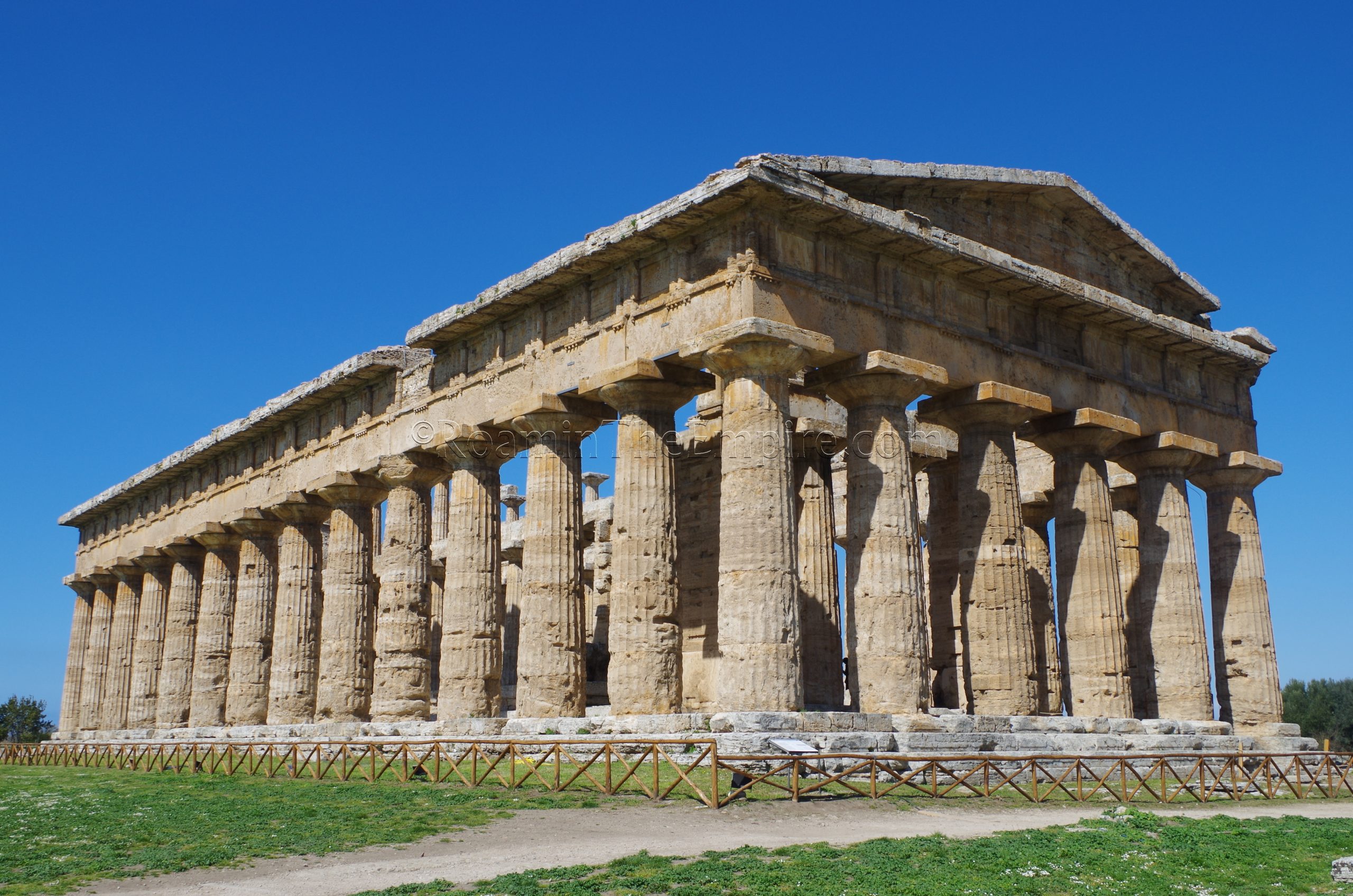
Continued From Paestum – Part I
Southern Sanctuary
Heading toward the southernmost part of the city and the southern sanctuary are the other two major temples of Paestum. The northern most of these two temples is the Temple of Hera II, or the Second Temple of Hera. Built between 460 BCE and 440 BCE, the temple was originally identified as belonging to Poseidon and later Neptune. It also variously associated with Apollo. While there are some finds to suggest that Poseidon was venerated at the temple (along with Zeus), the primary dedication seems to be to Hera. On the east side of the temple are two altars; a smaller Roman altar that is closest to the temple, and a larger Greek altar further away. The construction of a road in the Roman period that cut through the Greek altar necessitated the construction of the second altar.
In recent years, the interior of the Temple of Hera II has been opened up to visitors, who can walk along a delineated path between the exterior colonnade and the walls of the cella. The first couple times I visited, this was not possible, but, by the time I visited in the spring of 2019, it was open. This is particularly helpful in seeing the second tier of smaller columns atop the two interior colonnades that divided the cella into three sections.
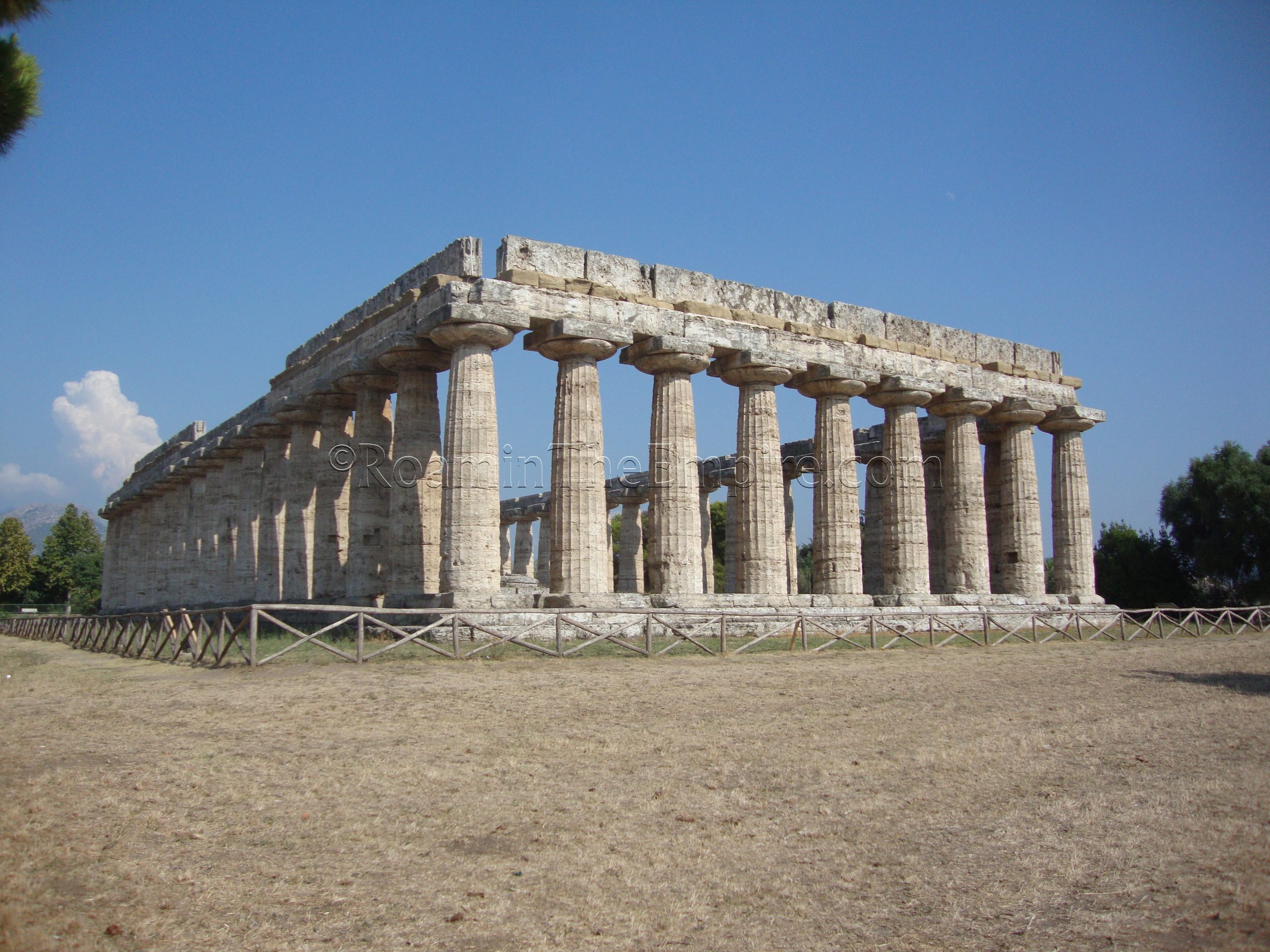
South of the Temple of Hera II is the earlier Temple of Hera, constructed about 450 BCE, making it the oldest of the three major temples at Paestum. This temple was originally identified as being a Roman basilica. It differs greatly in style from the later temple to Hera, most notably in the shorter columns and unusual width of the temple, evident in the unusual 9 column width and 18 column length (compared to the more standard 6 x 14 peripteral hexastyle of the Temple of Hera II). Little remains of the temple above the top of the level of the columns. Located on the west side is the Greek era altar. Access is allowed into the interior of the Temple of Hera as well, though only a few columns from the interior colonnade remain, and not much else of the interior structures of the temple.
The structures immediately north and south of this altar are sometimes identified as being treasuries. Surprisingly, I’ve not been able to find any specific information on the prominent structure to the northeast of the altar of the Temple of Hera. It does seem to be some sort of water feature, perhaps a fountain or a sacred pool of some sort. Further south from the temples is Paestum’s southern wall and the so-called Porta Giustizia, the southern city gate.
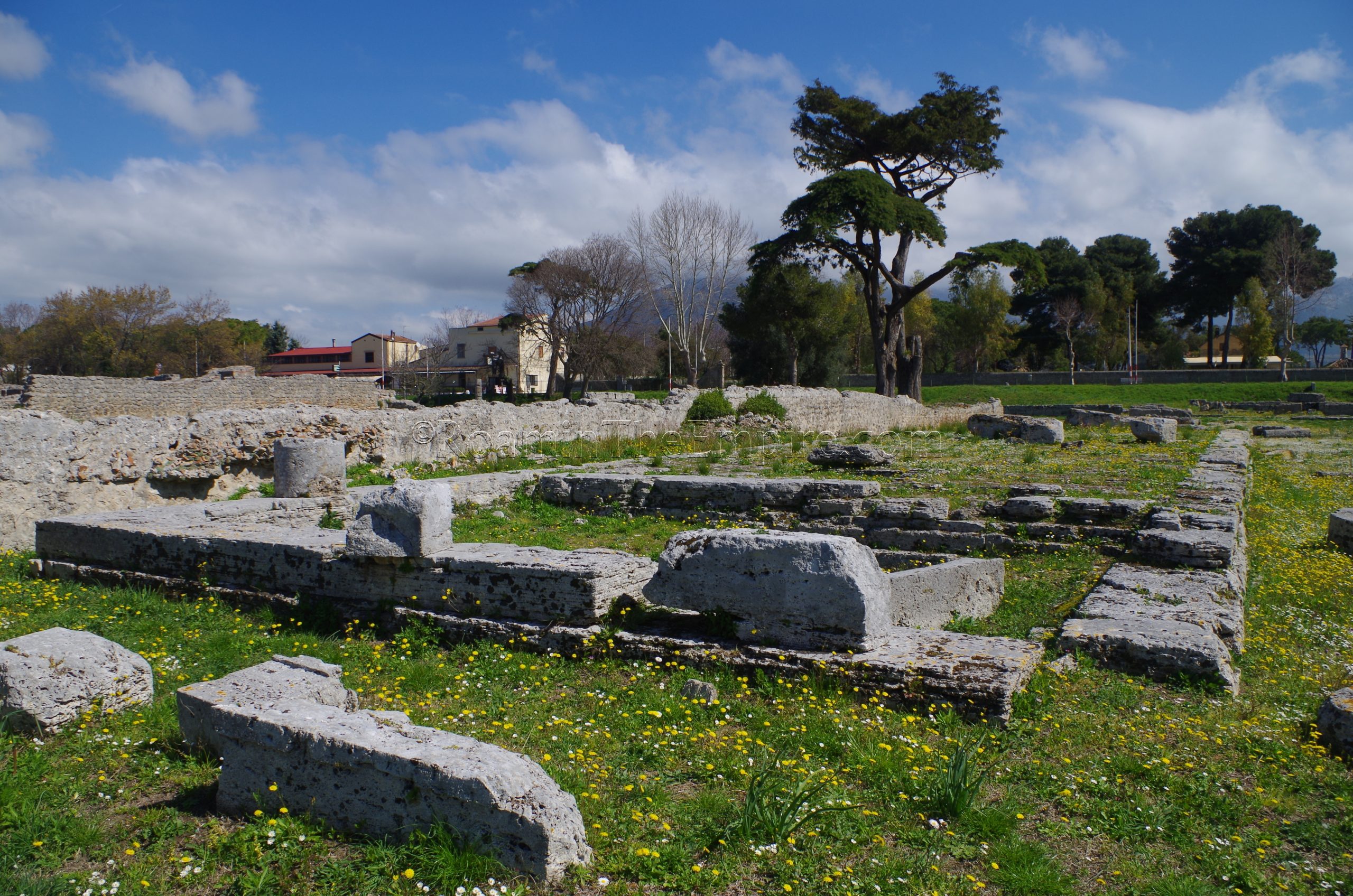
Continuing back to the north, from the Roman altar of the Temple of Hera II, there is a line of small altars erected during the Lucanian period along the east side of the path that heads back toward the forum. On the west side of the path, just north of the Temple of Hera II is a basin of some sort, perhaps for ritual ablutions of some sort. Further up the path at the northern side of the southern sanctuary are three structures west of the path. The first being a small shrine of unknown dedication and immediately north of that an amphiprostyle temple of uncertain dedication (though sometimes theorized to be to Hercules), but dating to the 4th century BCE, during the Lucanian control of the city. Beyond a low wall behind the amphiprostyle temple is a small temple dedicated to Mater Matuta. On the east side of the path at this area is the large Asclepion, the sanctuary to Asclepius. The most recognizable element of the Asclepion is a paved area immediately adjacent and parallel to the path. Like the altars and amphiprostyle temple, the Asclepion seems to date to the Lucanian period.
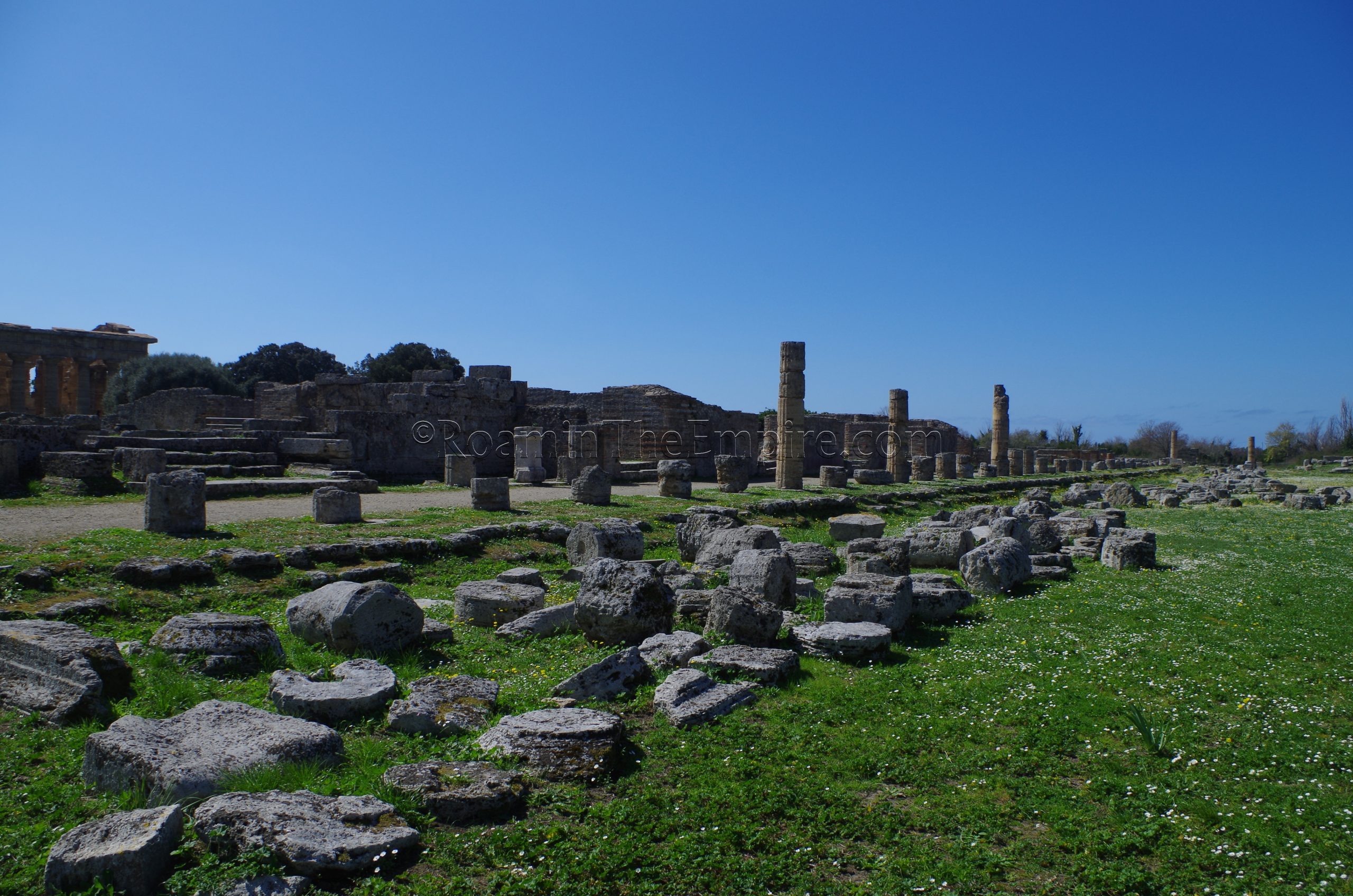
Forum
A brief stretch of ancient pavement takes the path back into the forum on the east side. Upon entering the forum area, tabernae line the southern edge of the forum to the east. The easternmost end of the forum is unexcavated; now below the street and modern buildings outside of the archaeological park. West of the path, along the south side of the forum is the macellum, the food market. The preservation of the walls here is relatively low, but there is enough left in some places to get the impression of market stalls around a central area. The macellum was constructed as part of the earliest plan of the forum following the establishment of a colony in 273 BCE. Beyond that is the curia. An entryway behind the macellum also gives access to walled area where the Temple of Mater Matuta is located.
The path then leads across the forum to the north end of the forum. Like the south end, tabernae line the forum from the east side of the path to the edge of the park. The room behind the line of tabernae is identified as perhaps being a carcer, a jail. Immediately west of the path is the comitium, the meeting place of the comitia, who elected the local magistrates. The comitium is one of the earliest constructions during the Roman period; a rounded amphitheater-like structure (though much smaller) with circular seating. Though it was important early on in the Roman period, it lost some of its functionality in the 2nd century BCE, when part of it was ceded to the construction of the adjacent temple, which cuts out a significant portion of the seating on the west side.
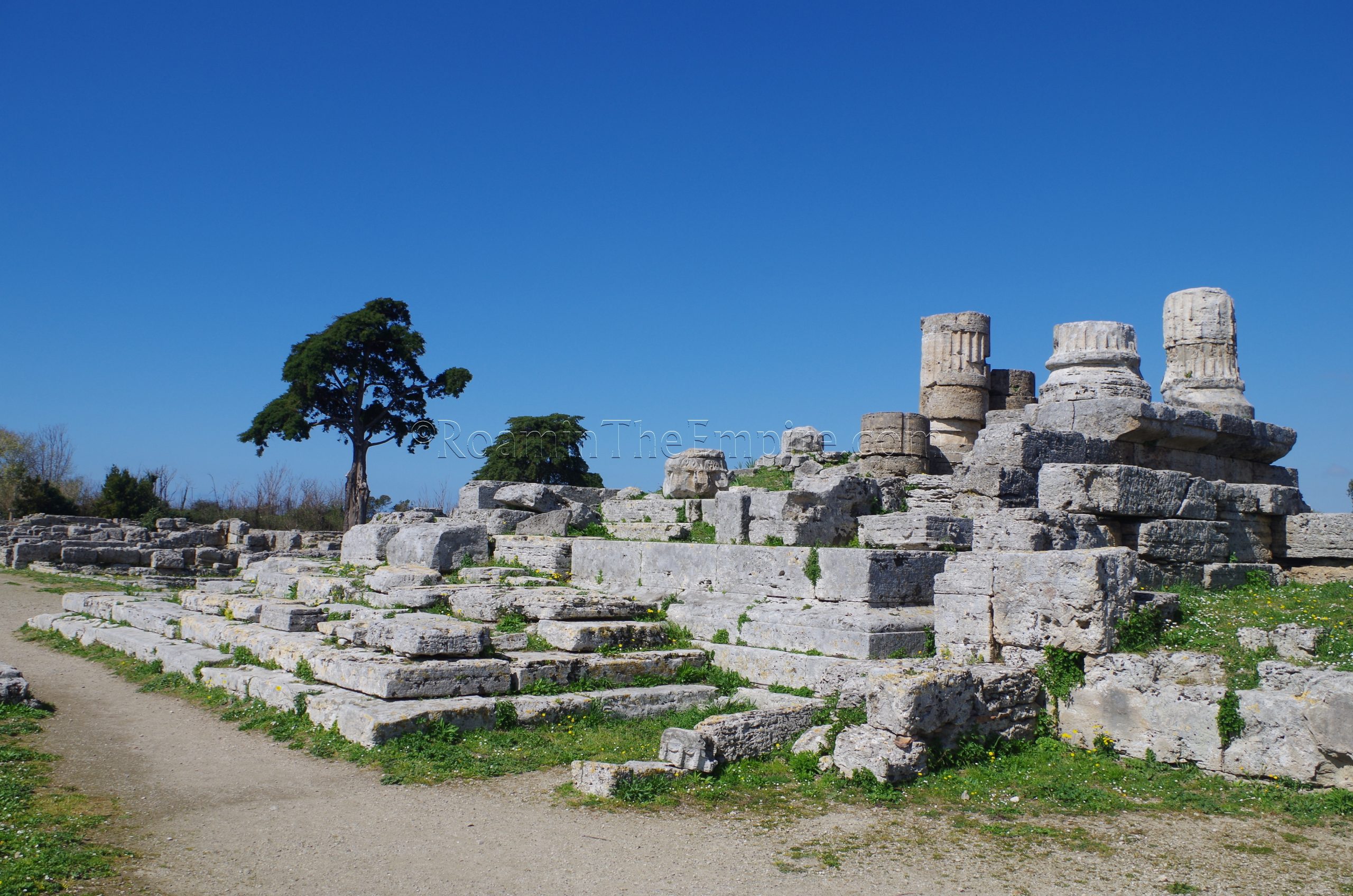
The temple that encroaches on the comitium is that of the Mens Bona, the good mind. The prominent location on the forum has inaccurately led to its identification as being dedicated to the Capitoline Triad, but the single cella, rather than the tripartite cella a Capitolium would have, renders that identification as erroneous. It has also been incorrectly identified as the Temple of Peace. The temple was constructed at some point in the 2nd century BCE.
Amphitheater
Northeast of the comitium is the amphitheater of Paestum. Only about half the amphitheater is excavated, with the other half meeting the same fate as the east end of the forum, being buried beneath the modern road and buildings outside of the park. It is said that part of the amphitheater was actually destroyed in the construction of the road, rather than simply left unexcavated. The amphitheater was originally constructed in the middle of the 1st century BCE, making it one of the oldest known examples in the Roman world. The amphitheater was expanded in the 1st century CE to include the outer ring, which spread into the road and nearly up against the adjacent comitium. This outer ring probably supported upper tiers of wood cavea. The location of the amphitheater so close to the forum is rather unusual, though Republican era amphitheaters do tend to be more centrally located than later amphitheaters, but typically not quite so close to the center of the city.
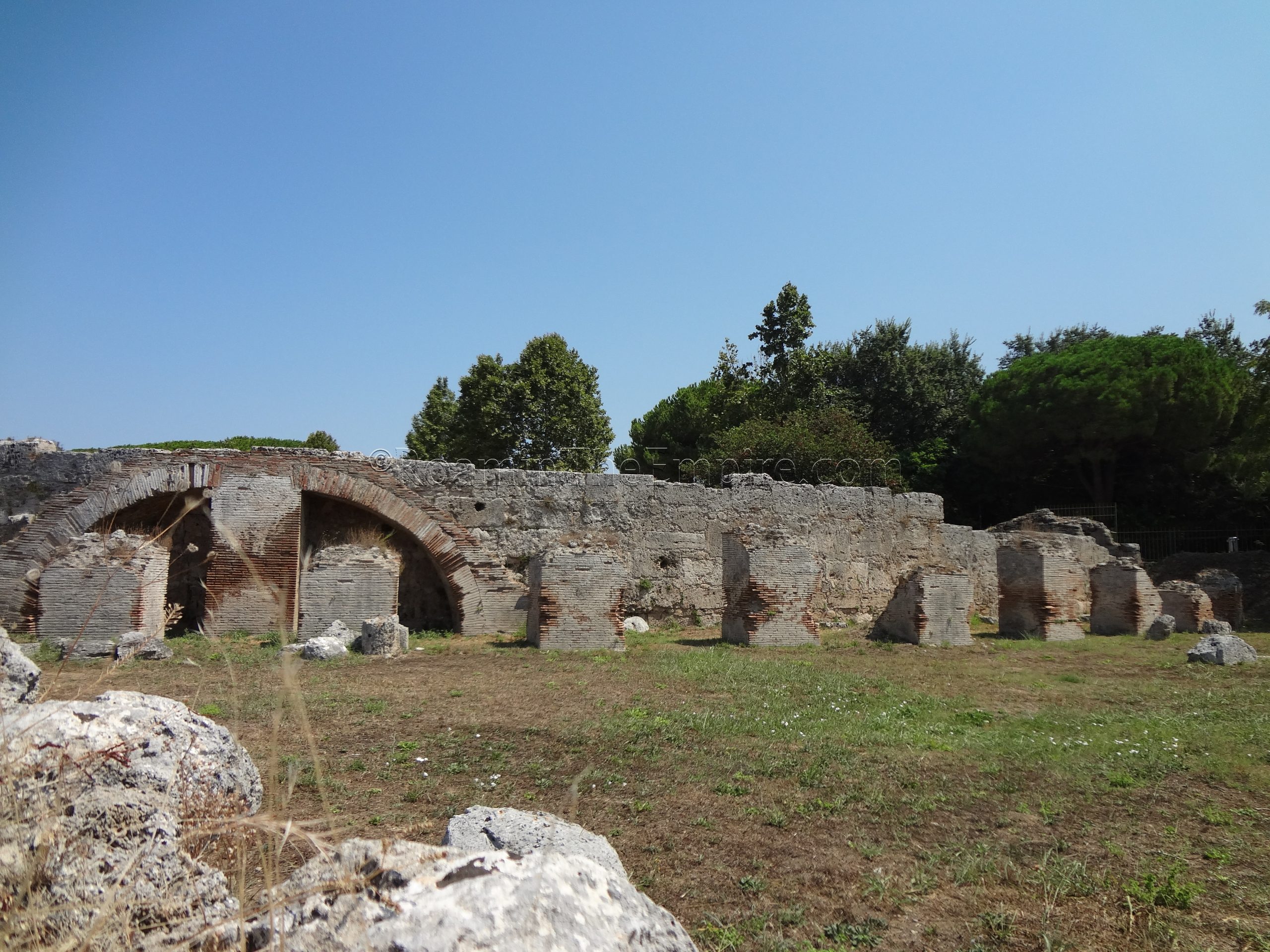
North from Paestum’s amphitheater, the path once again travels into the residential area built in the area of the former Greek agora. Along the eastern extent of the park, about 50 meters from the amphitheater, is the ekklesiasterion, another element remaining from the agora. Originally constructed about between 480 and 470 BCE, the ekklesiasterion served as a meeting place for political assemblies in the Greek city. The site retained its function during the Lucanian period, but after the settlement of the Roman colony, the construction of the comitium served a similar function and the ekklesiasterion was built over with a sanctuary. Part of this Roman era sanctuary is visible immediately to the north of the ekklesiasterion. The scant remains of a small temple to Zeus Agoraios are located just west of the ekklesiasterion.
Getting through the site averages me about an hour and a half among three visits. It should take no less than an hour to do it properly, even as a casual visitor, but, has taken me as long as over 2 hours. It is a sizable site, but is not overwhelming. Most people are there for the temples, but, there’s obviously a lot to see beyond that for anyone that wants to take their time. There are a number of informational signs on-site with Italian and English information as well as diagrams and maps explaining the layout of some of the remains.
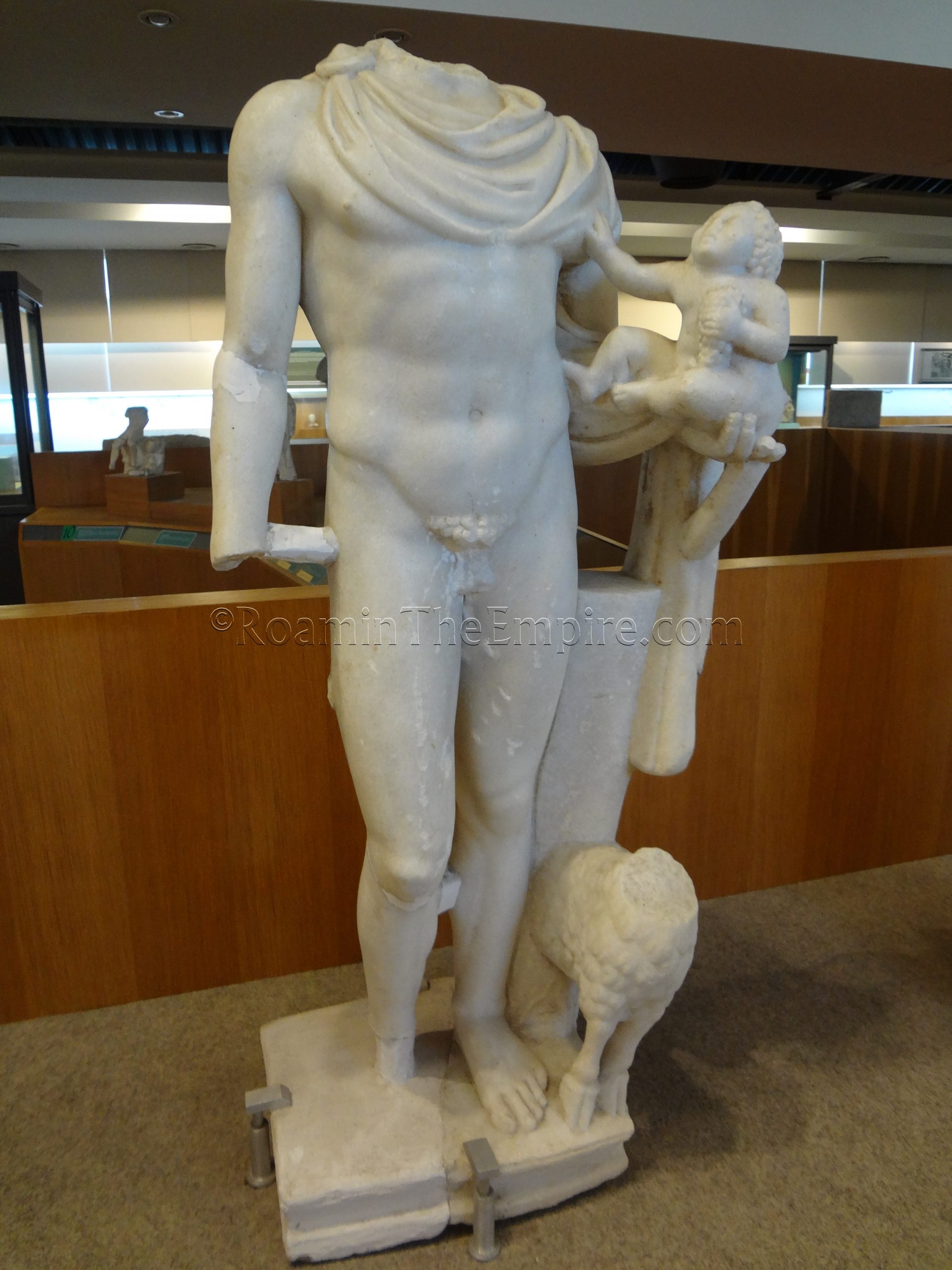
Museum
Just across the street from the archaeological park, located at Via Magna Graecia 917, is the Museo Archeologico Nazionale di Paestum. The museum is open Tuesday through Sunday from 8:30 to 19:30; it is closed on Mondays. The combined admission for the site and museum is 6 Euros. A cumulative ticket that includes entrance to the archaeological site of Velia, about 45 kilometers south, is 8 Euros. In the event of the site closing for some reason, the museum only ticket is 4 Euros.
As one might expect given that the biggest draws at Paestum are the Greek temples, the museum collection is pretty heavily Greek leaning. One of the more interesting displays is that of the metopes from the temple of Argive Hera (also called the Heraion) at the mouth of the Sele River about 8 kilometers to the northwest. These metopes are displayed along the top of a central structure, replicating their placement on the temple in antiquity. These can then be viewed from a second story gallery. I thought it was kind of a cool means of presentation.
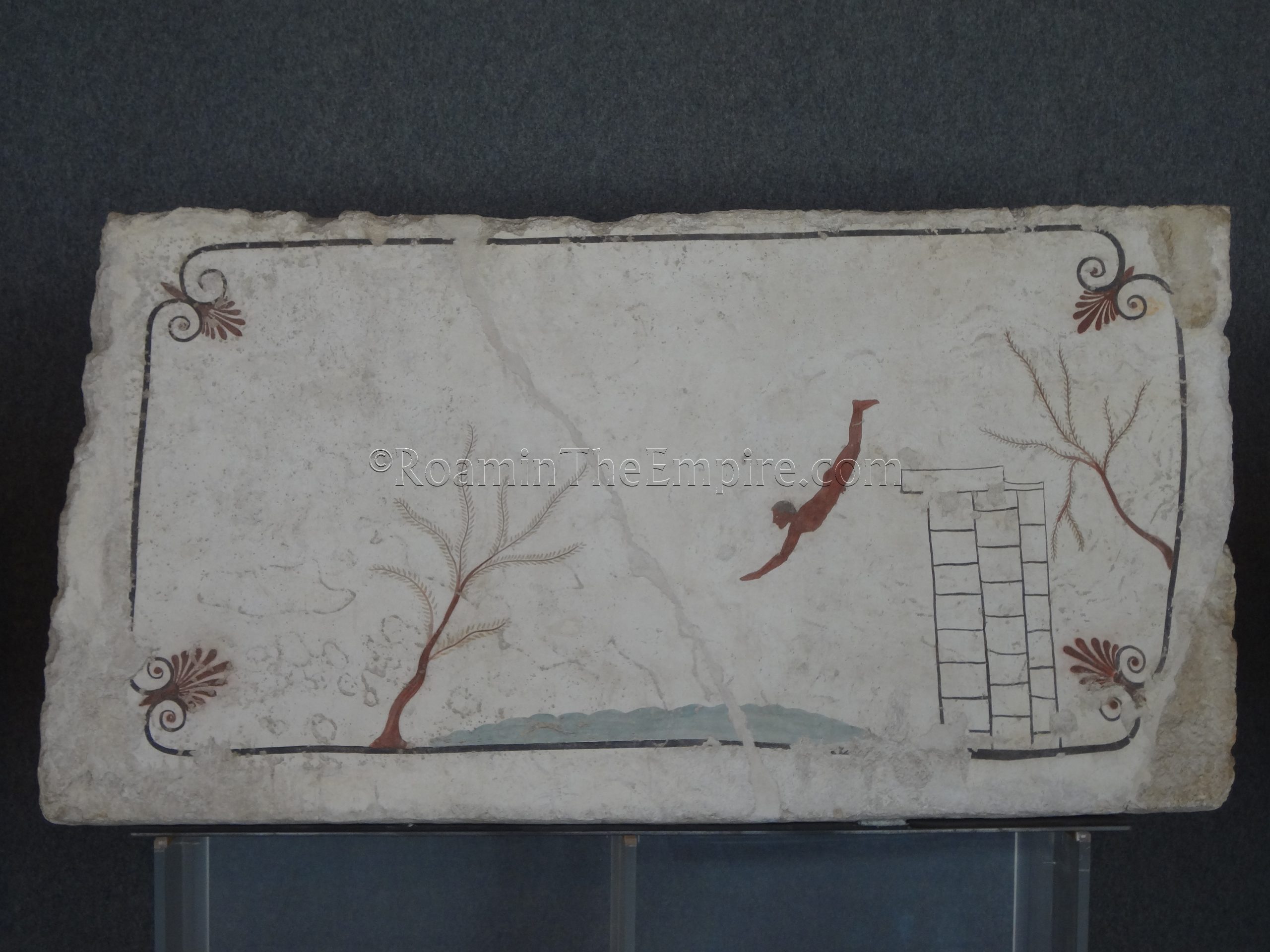
The collection of painted tomb panels from the southern necropolis is also quite worth seeing. The tombs date from the Greek and Lucanian periods of occupation. The Greek tomb, the famous Tomb of the Diver, is considered to be the only complete examples of figural Greek wall painting from the Orientalizing, Archaic, or Classical periods to have survived (thus far). Estimated to date to around 470 BCE, the Tomb of the Diver was likely influenced by the Etruscan tomb paintings, as the Etruscans had expanded to just a few kilometers away from Paestum by the start of the 5th century CE. It continued through the Lucanian period, from which the bulk of the examples in the museum date, frequently featuring horse motifs.
The museum also has a small collection of Roman objects that includes statuary, inscriptions, and some other miscellaneous finds. Some of the more interesting artefacts are a bronze statue of Marsyas, a few bronze military diplomas, and a bronze tabula patronatus from 347 CE.
Overall, the museum took me a little more than an hour to go through. The Tomb of the Diver is one of the most famous pieces of ancient art, and should not be missed given the opportunity. Though it should be noted that some or all of the panels are occasionally lent out for exhibitions. The rest of the museum is well worth visiting too, all the painted tomb panels are quite interesting. The one drawback to the museum, for those that don’t speak Italian, would be that there is almost no information in the museum in any other languages. The painted tombs have small English translations, but, that’s about it. Which kind of speaks to what the curators perceive as the biggest draw in the museum. Even in the summer, though, it’s not very crowded. I suspect most visitors don’t give a worthwhile look at the museum.
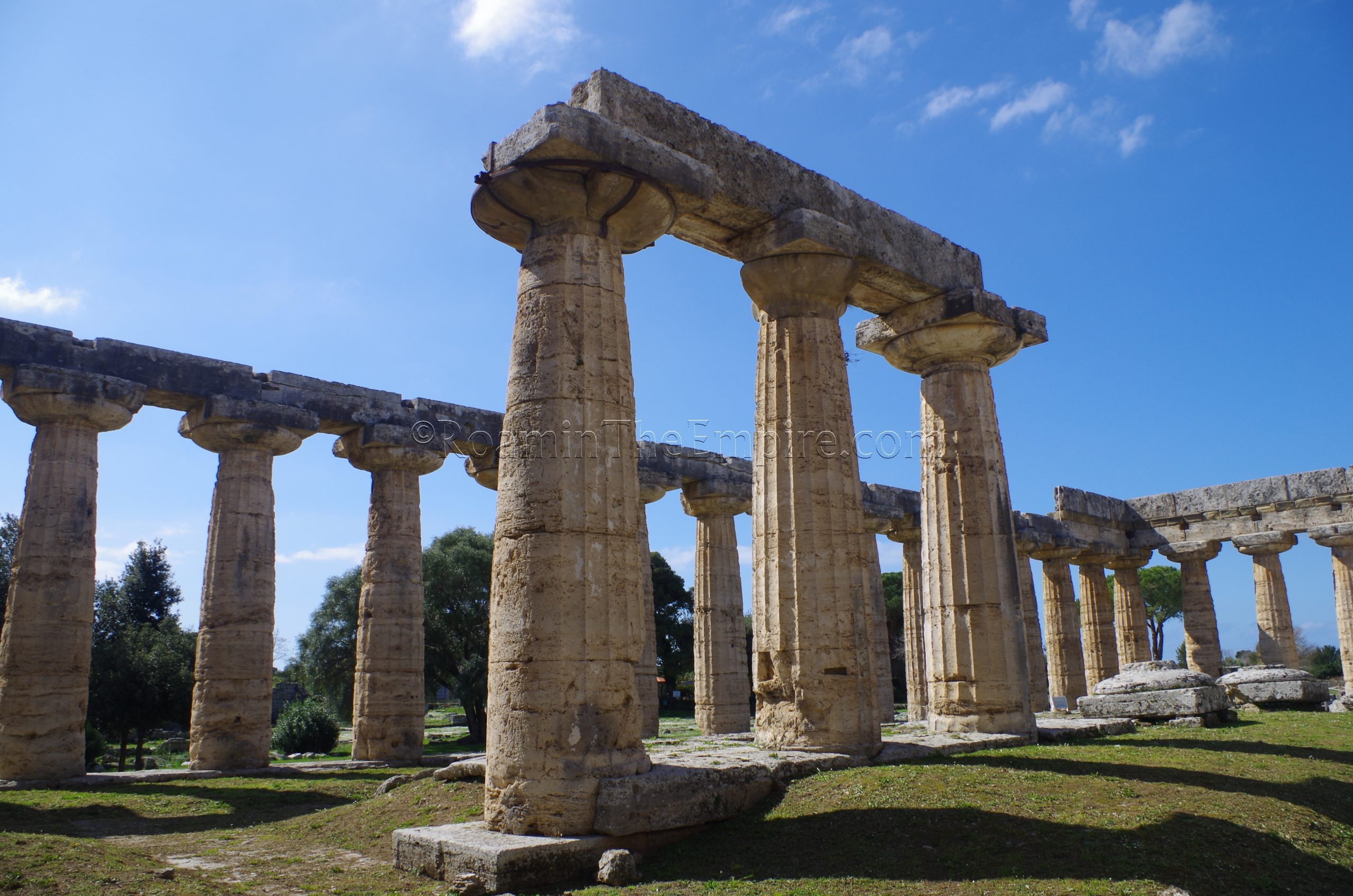
In the area of Paestum, there is the site of the Temple of Argive Hera, which is currently closed and has been for some time, though there are supposedly restoration works underway for the museum on site. There doesn’t seem to be significant remains of the temple standing, though, mostly just foundations. There is also a sanctuary to Aphrodite about 250 meters to the southeast of the Porta Giustizia. It was overgrown and access was limited when I tried to see, but I imagine there are times when it is more accessible.
Sources:
Aristotle. Politics, 5.1303a
Grant, Michael. A Guide to the Ancient World: A Dictioniary of Classical Place Names. New York: Barnes & Noble Books, 1997.
Halloway, R. Ross. “The Tomb of the Diver.” American Journal of Archaeology, vol. 110, no. 3, 2006, pp. 365-388.
Livy. Ab Urbe Condita, 8.17.8.
Martial. Epigrams, 9.26.
Mello, Mario. “Paestum: A City, a Civilization, a Heritage.” The Journal of Aesthetic Education, vol. 19, no. 1, 1985, pp. 9–22.
Ovid. Metamorphoses, 15.680.
Scullard, H. H. A History of the Roman World 753 to 146 BC. London: Routledge, 1991.
Solinus, Gaius Julius. De Mirabilibus Mundi, II.
Stillwell, Richard, William L. MacDonald, and Marian Holland. McAllister. The Princeton Encyclopedia of Classical Sites. Princeton, NJ: Princeton U Press, 1976.
Strabo. Geographica, 5.4.13.
Vergil. Georgics, 4.116.
Welch, Katherine E. The Roman Amphitheatre: From Its Origins to the Colosseum. Cambridge University Press, 2007.


